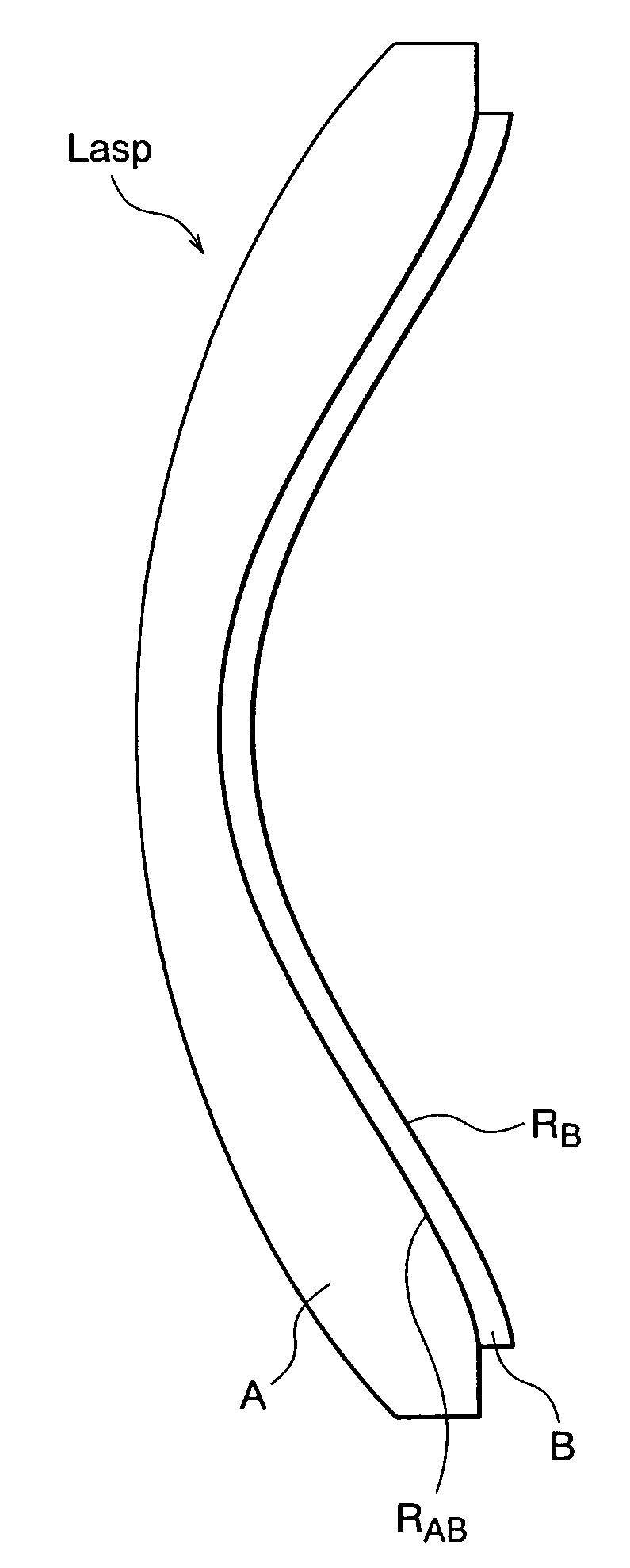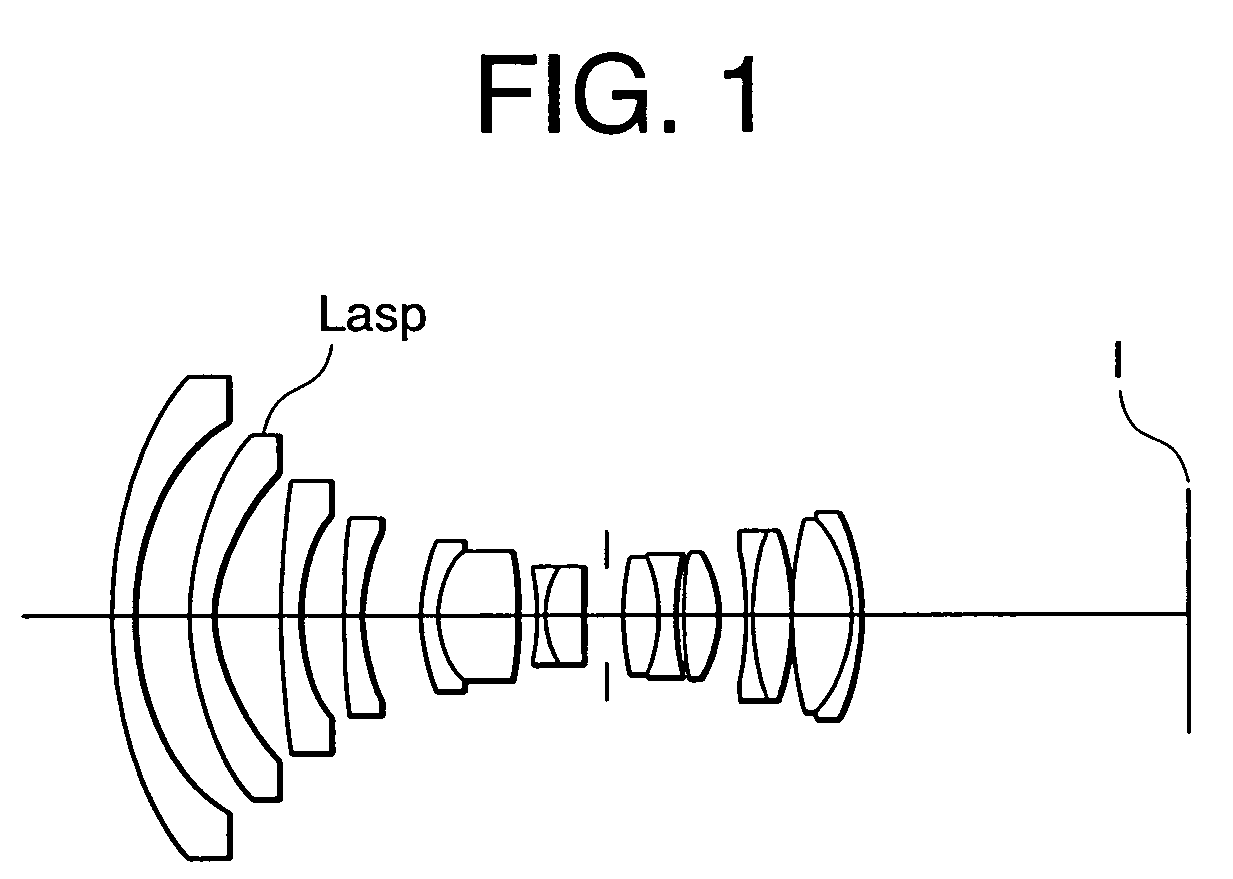Aspherical lens and optical instrument using the same
a technology applied in the field of aspherical lenses and optical instruments, can solve the problems of narrow degree of freedom upon fabricating a large aspherical lens in particular, the restriction of designing an aspherical surface, and the high cost of fabricating, so as to achieve good optical performance, large degree of freedom in design, and compact dimension
- Summary
- Abstract
- Description
- Claims
- Application Information
AI Technical Summary
Benefits of technology
Problems solved by technology
Method used
Image
Examples
example 1
[0061]FIG. 1 is a diagram showing a lens construction of a super wide-angle lens equipped with an aspherical lens according to Example 1 of the present invention. FIG. 2 schematically shows the aspherical lens according to the present invention.
[0062]In the super wide-angle lens shown in FIG. 1, the present invention is applied to the second lens element Lasp from the object side. As shown in FIG. 2, the lens element Lasp is composed of a compound type aspherical lens constructed by a negative meniscus lens A (substrate member A) having a convex surface facing to the object and an aspherical surface RAB with low fabrication accuracy formed on a concave surface, and a resin layer B (member B) having substantially the same thickness formed on the image side of the lens A having an aspherical surface Rb with high fabrication accuracy facing to the image. Incidentally, the above-described construction of the lens Lasp is commonly used in each Example applying an aspherical lens accordin...
example 2
[0081]FIG. 4 is a diagram showing lens construction of a zoom lens system equipped with an aspherical lens according to Example 2 of the present invention together with a moving trajectory of each lens group upon zooming.
[0082]As shown in FIG. 4, the zoom lens system according to Example 2 of the present invention is a so-called negative-positive two-group zoom lens composed of, in order from an object, a negative lens group and a positive lens group. In Example 2, an aspherical surface is included in the most object side lens, the third lens from object side that is a compound type aspherical lens constructed by a glass material and a resin material, and the most image side lens that is a glass aspherical lens. In Example 2, the present invention is applied to the most object side lens Lasp.
[0083]Various values associated with a zoom lens system equipped with an aspherical lens according to Example 2 of the present invention are shown in Table 2.
[0084]
TABLE 2[Specifications]WTf =12...
example 3
[0091]FIG. 7 is a diagram showing a lens construction of a super wide-angle lens equipped with an aspherical lens according to Example 3 of the present invention.
[0092]The super wide-angle lens shown in FIG. 7 has basically the same construction as the super wide-angle lens according to Example 1 and the present invention is applied to the second lens Lasp from the object side.
[0093]Various values associated with a super wide-angle lens equipped with an aspherical lens according to Example 3 of the present invention are shown in Table 3.
[0094]
TABLE 3[Specifications]f =9.62ω =112.9°FNO =2.8[Lens Data]rdνn 1)46.02093.0042.721.83481 2)29.87426.55 3)33.49952.4749.521.74443 4*)13.77220.0353.221.69350(Lasp) 5*)13.77228.50 6)163.14572.0065.471.60300 7)23.11394.87 8*)37.11360.5038.091.55389 9)181.74131.8049.611.7725010)22.75076.9111)25.47021.8042.721.8348112)11.76159.4734.471.6398013)−33.11292.0514)−71.18911.3142.721.8348115)10.60094.7934.471.6398016)−62.12882.5017>0.00002.50Aperture Stop18...
PUM
 Login to View More
Login to View More Abstract
Description
Claims
Application Information
 Login to View More
Login to View More - R&D
- Intellectual Property
- Life Sciences
- Materials
- Tech Scout
- Unparalleled Data Quality
- Higher Quality Content
- 60% Fewer Hallucinations
Browse by: Latest US Patents, China's latest patents, Technical Efficacy Thesaurus, Application Domain, Technology Topic, Popular Technical Reports.
© 2025 PatSnap. All rights reserved.Legal|Privacy policy|Modern Slavery Act Transparency Statement|Sitemap|About US| Contact US: help@patsnap.com



